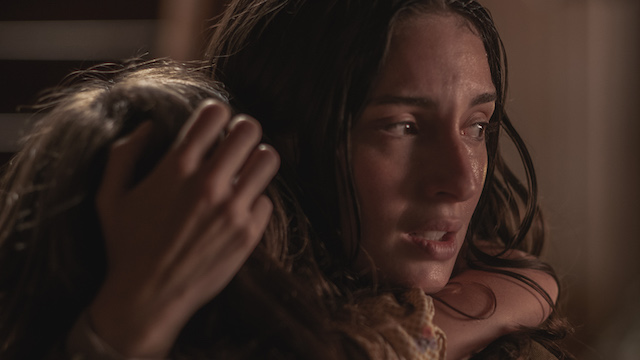Horror-thriller Fever Dream is now streaming on Netflix. Based on the Spanish novel, it takes place in Argentina and deals with several environmental problems in the country.
“A young woman lies dying far from home. A boy sits beside her. She is not his mother. He is not her child,” says the official synopsis. “Together, they tell a haunting story of broken souls, an invisible threat, and the power and desperation of family.”
ComingSoon Editor-in-Chief spoke with Fever Dream director Claudia Llosa (Aloft) and author Samanta Schweblin to discuss the Netflix adaptation of the critically acclaimed novel.
Tyler Treese: Claudia, I was curious about when you first became aware of Samanta’s work and what it was about Fever Dream that really stood out as a novel for you to want to adapt it?
Claudia Llosa: A really close friend gave me the book right after it was published in Spain. She told me that I should read it and she didn’t tell me why. It’s the gesture I will always remember, and I will always be thankful to her for doing that. This novel had such a deep impact on me. It took me on a journey that was spectacular and very visceral, very physical.
The idea of having a name for this fear that when perceived in a very concrete and intense way, connected to what motherhood is. The idea of how you look at your children as a parent, the idea of needing to find a balance and between, on the one hand to give them freedom so that they can explore life, but at the same time, being there for them to protect them. To take care of them so that nothing bad happens to them. So this feeling of constantly calculating and recalculating this distance and having the safety, so that one is not distracted, but at the same time, you’re not putting pressure on them and you’re not suffocating them. Well, it is a fear that is very important to explore and then connected to the decision that happens at the end, the social reporting that happens at the end. I thought it was two very important moments that are a component of the story.
Samanta, it has to be so exciting to see your work come to life on film. How does it feel to see your story and these characters that you came up with portrayed so well? I thought the film was excellent.
Samanta Schweblin: It was a very privileged situation that I found myself in. First of all, it was wonderful to work with Claudia. She is a great director and somebody to work with, which is fantastic. Then the writing process was very interesting. I learned so much, I really had fun and it was so great to discover the story, applying it to such a different style. That’s what you need for cinema, as opposed to literary writing. And then it is a privilege because very few times can an author go through this journey in such a close way. Claudia gave me space and room for maneuver and she allowed me to be there throughout the whole time. Even up to the editing and we discussed actresses, we discussed everything. She really gave me a lot of space, a lot of room for participating.
She was very generous with me, and so I felt that the film was very close to me. I didn’t feel it was something foreign. I felt that it was something very close to me, very close to the novel, but at the same time, something that’s different. Something that’s separate because literature is one thing and cinema is another thing. But in terms of its essence, they are very close to each other.
Claudia, the film, much like the novel, is told in a very fascinating way. There’s this narration and a conversation between Amanda and David. It worked great in the book and it does here as well. Was it a challenge to tell the story that way?
Claudia Llosa: Well, it was definitely a challenge. First of all, because of the offscreen voice, which is something very new in terms of this dialogue, which needs to not only be constantly present but one needs you to feel that it doesn’t suffocate the story, rather the opposite. It is there to accompany the story and give order to it. So it needs to be something evocative that also allows the film to grow.
At the same time, it needs to support or grab people’s attention with very few elements. So there are these women that are talking to each other and then there’s this other element, and I need to create tension with very few elements. For me, that is something very new and it’s something that I was deeply drawn to. I was very curious about it. Of course, undoubtedly, there was this feeling that I was diving into a void, but I did that. … We had read the story over and over. So in the script, we kept what needed to be kept. So in the film, we were able to keep this feeling of a very deep and strong emotional journey. That to me is what the novel likes me to feel.
Samanta, Megan McDowell released a great translation of the novel, and this film is subtitled and even has an English dub. As a creator, how does it feel to know that a worldwide audience can enjoy your work?
Samanta Schweblin: I’m very happy that you’re asking about Megan McDowell because I really admire her work. I think she’s a wonderful translator. I feel very, very safe with those translations, but it is interesting because it’s a different kind of translation because there’s a similarity between what happens in a translation in terms of languages and then a translation from literature to film. When you are working on a translation, the author is in a very inconvenient position because it’s one’s own words. At the same time, they no longer are. It’s on her to find one spot to sometimes to choose a word that as an author, you spend a week or a month. So the idea that there’s something else that rereads your words and then chooses other words, well, that’s something that puts you in a weird spot. So I find that the translation needs to be deeply rooted into communication. So I am a reader of the translation and I think it’s a great gift for me when I read a well-done translation and I love this movement between languages.










